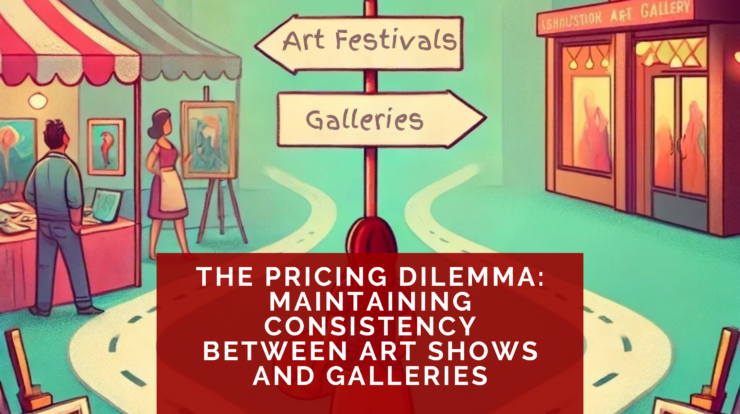
An artist recently asked me, “I sell my work at art fairs and festivals, but I’m also starting to work with galleries. Should my prices be the same in both places?” It’s a great question and one I’ve heard many times over the years. I’ve been in the gallery business since 1993, and I’ve worked with countless artists who grapple with this pricing dilemma. The temptation to lower prices at direct sales venues in hopes of increasing sales is understandable, but when you’re aiming for gallery representation, pricing consistency becomes critical. Let’s explore why consistent pricing matters and how you can navigate the transition from craft shows to gallery representation.
Why Pricing Consistency Matters
When you’re represented by a gallery, that gallery invests time, space, and resources into promoting and selling your artwork. They are effectively a partner in your success. If a collector or gallery owner discovers that you’re offering your work at significantly lower prices elsewhere, that discovery can damage trust—both from collectors and gallery owners. A painting that’s priced 30% less at a show than in the gallery can leave buyers feeling confused or even cheated. Galleries need to know that they are competing on a level playing field, and collectors need to feel confident that they are making a fair purchase.
Navigating Different Sales Environments
Art and craft shows often feel like a different market entirely. Buyers walking a show floor may be more inclined to pick up small, functional pieces or hunt for bargains. You could be displaying high-priced sculpture right next to an artisan selling hand-carved wooden spoons. That contrast can create pressure to lower your prices to match the expectations of a casual buying audience.
In my experience, when your prices rise above a certain threshold, it becomes more challenging to sell at shows focused on lower-cost offerings. That’s often why artists transition to galleries in the first place—galleries cultivate an environment where collectors expect to invest in fine art at higher price points. While this doesn’t mean you must abandon all festival opportunities, it does mean that you should be strategic about which events align with your market level and brand.
Managing the Transition Period
It’s natural to go through a transition period where you’re still participating in a mix of shows and festivals while working toward gallery representation. During this time, you may maintain the pricing structure you’ve used for fairs—though I would recommend only doing this temporarily. Once galleries begin actively showing your work and collectors start purchasing through them, it’s critical to align all your prices to maintain consistency. If a particular show becomes unprofitable or challenging because of your pricing strategy, it might be time to let it go.
Choosing the Right Venues
Not every show is the right fit for your work. If an event feels like a race to the bottom, where you’re expected to steeply discount your work to compete, it may no longer serve your long-term goals. By moving away from marginal events, you can focus on galleries and higher-tier shows that better reflect the value of your work and attract serious collectors.
Communicating Your Value
Maintaining consistent pricing is only part of the equation. You also need to convey why your work is worth the price you set. Galleries naturally provide an environment where collectors understand the investment in fine art, but if you’re participating in festivals or fairs, you may need to educate buyers on what makes your work special. Use signage, marketing materials, and personal conversations to explain the time, skill, and creativity involved in your process. Sharing images of your studio, work-in-progress shots, or details about your inspirations can go a long way in justifying your pricing.
Thinking Long-Term
It can be discouraging to experience a slow show, especially when you see lower-priced functional items selling well. However, if your goal is to build a strong brand, maintain healthy profit margins, and develop lasting relationships with collectors through galleries, consistent pricing is essential. As you gain traction and establish yourself in the fine art market, it becomes easier to walk away from venues that don’t align with your pricing structure.
Setting Your Prices Based on Market Research
Instead of guessing at your pricing, base it on solid market research. Study how other artists creating work similar to yours price their pieces, particularly those who are showing in galleries and venues you aspire to be in. Understanding market expectations will help you establish a pricing strategy that aligns with your goals while maintaining consistency across all your sales channels. If you need guidance, I’ve written a post that will help: Price It Right: The Artist’s Guide to Smarter Pricing.
Final Thoughts
Pricing is a crucial factor in your long-term success as an artist. By maintaining consistency, choosing the right venues, and effectively communicating the value of your work, you can create a sustainable pricing structure that supports both direct sales and gallery representation. Have you faced the challenge of balancing pricing between different venues? I’d love to hear about your experiences. Feel free to share your thoughts in the comments below.
I’m facing this dilemma at the moment. Not a fair but an open studio event. I am not yet represented but am toying with the idea of offering a discount. Living in a rural location it’s sometimes difficult to get people motivated to visit. The question is still relevant though. Does it cheapen the artworks by advertising a discount on flyers to try and get prospective collectors through the door. My argument is that I save on post and packing.
A discount can be a good incentive, especially in a rural area, but I’d frame it differently—perhaps as a limited-time opportunity to purchase directly before the work goes to a gallery. You might also offer free local delivery or a small gift with purchase. The key is to keep pricing consistent while creating urgency and value for buyers.